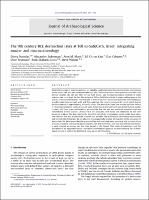Please use this identifier to cite or link to this item:
https://hdl.handle.net/20.500.12202/3989Full metadata record
| DC Field | Value | Language |
|---|---|---|
| dc.contributor.author | Katz, Jill | - |
| dc.date.accessioned | 2018-10-17T19:25:45Z | - |
| dc.date.available | 2018-10-17T19:25:45Z | - |
| dc.date.issued | 2011-12 | - |
| dc.identifier.citation | Katz, Jill Citron, Dvory Namdar, Alexander Zukerman, Aren M. Maeir, Dan Cabanes, Clive Trueman, Ruth Shahack-Gross, Steve Weiner. The 9th century BCE destruction layer at Tell es-Safi/Gath, Israel: integrating macro- and microarchaeology. Journal of Archaeological Science 38(12) December 2011: 3471-3482. | en_US |
| dc.identifier.issn | 0305-4403 | - |
| dc.identifier.uri | http://dx.doi.org/10.1016/j.jas.2011.08.009 | en_US |
| dc.identifier.uri | https://hdl.handle.net/20.500.12202/3989 | - |
| dc.description.abstract | Destruction events in multi-period sites are valuable marker horizons that represent time-synchronous events across the site and sometimes between sites. Destruction layers often preserve rich finds that provide insights into site use. Here we use both macro- and microarchaeological methods to study a destruction event from the late 9th century at Tell es-Safi/Gath in Israel. A major conflagration at this specific location resulted in the consolidation of parts of the roof construction materials, thus enabling us to differentiate between roof, walls and floor materials. We could reconstruct the events which lead to the formation of an approximately 80 cm thick layer. The base of this layer that overlies the floor surface is a thin charred organic material-rich ash layer. As the clays in this layer were not altered by heat and the ceramics still have preserved residues, we conclude that the ash was produced elsewhere and was redistributed to this location. Ceramics that are associated with burnt roof sediments do not have preserved residues. We also estimate the time that each of the accumulation events might have taken, and conclude that this accumulation occurred over decades. The architecture and artifacts found within and beneath the destruction do not allow us to unequivocally identify the function of this area prior to destruction. We do however identify an unusual bin and associated stone pavement, and a corner rich in artifacts, phytoliths and charred organic material. We also show that a wall was built of fired mud bricks; a most unusual occurrence for this time period in the Levant. This study demonstrates well the usefulness of an integrated macro- and microarchaeological approach to understanding the archaeological record, as well as the benefits of using an on-site laboratory. | en_US |
| dc.description.sponsorship | Acknowledgments We thank Prof Israel Finkelstein for his helpful comments. This study was under the auspices of the European Research Council under the European Community’s Seventh Framework Programme (FP7/2007-2013)/ERC grant agreement no. 229418. It was also supported in part by the Kimmel Center for Archaeological Science, Weizmann Institute of Science, and by a grant (to A. Maeir) from the Israel Science Foundation (grant number 324/10). D.C. has a postdoctoral fellowship from the Beatriu de Pinós program (Departament d’Universitats, Recerca i Societat de la Informació de la Generalitat de Catalunya). | en_US |
| dc.language.iso | en_US | en_US |
| dc.publisher | Elsevier | en_US |
| dc.rights | Attribution-NonCommercial-NoDerivs 3.0 United States | * |
| dc.rights.uri | http://creativecommons.org/licenses/by-nc-nd/3.0/us/ | * |
| dc.subject | Microarchaeology | en_US |
| dc.subject | Destruction processes | en_US |
| dc.subject | Phytoliths | en_US |
| dc.subject | Residue analysis | en_US |
| dc.subject | Micromorphology | en_US |
| dc.subject | Fired bricks | en_US |
| dc.title | The 9th century BCE destruction layer at Tell es-Safi/Gath, Israel: integrating macro- and microarchaeology. | en_US |
| dc.type | Article | en_US |
| local.yu.facultypage | https://www.yu.edu/faculty/pages/katz-jill | |
| Appears in Collections: | Stern College for Women -- Faculty Publications | |
Files in This Item:
| File | Description | Size | Format | |
|---|---|---|---|---|
| KatzJill 9th century destruction level JArchaeological Science 2011.pdf | post-print from publisher | 822.35 kB | Adobe PDF |  View/Open |
This item is licensed under a Creative Commons License

